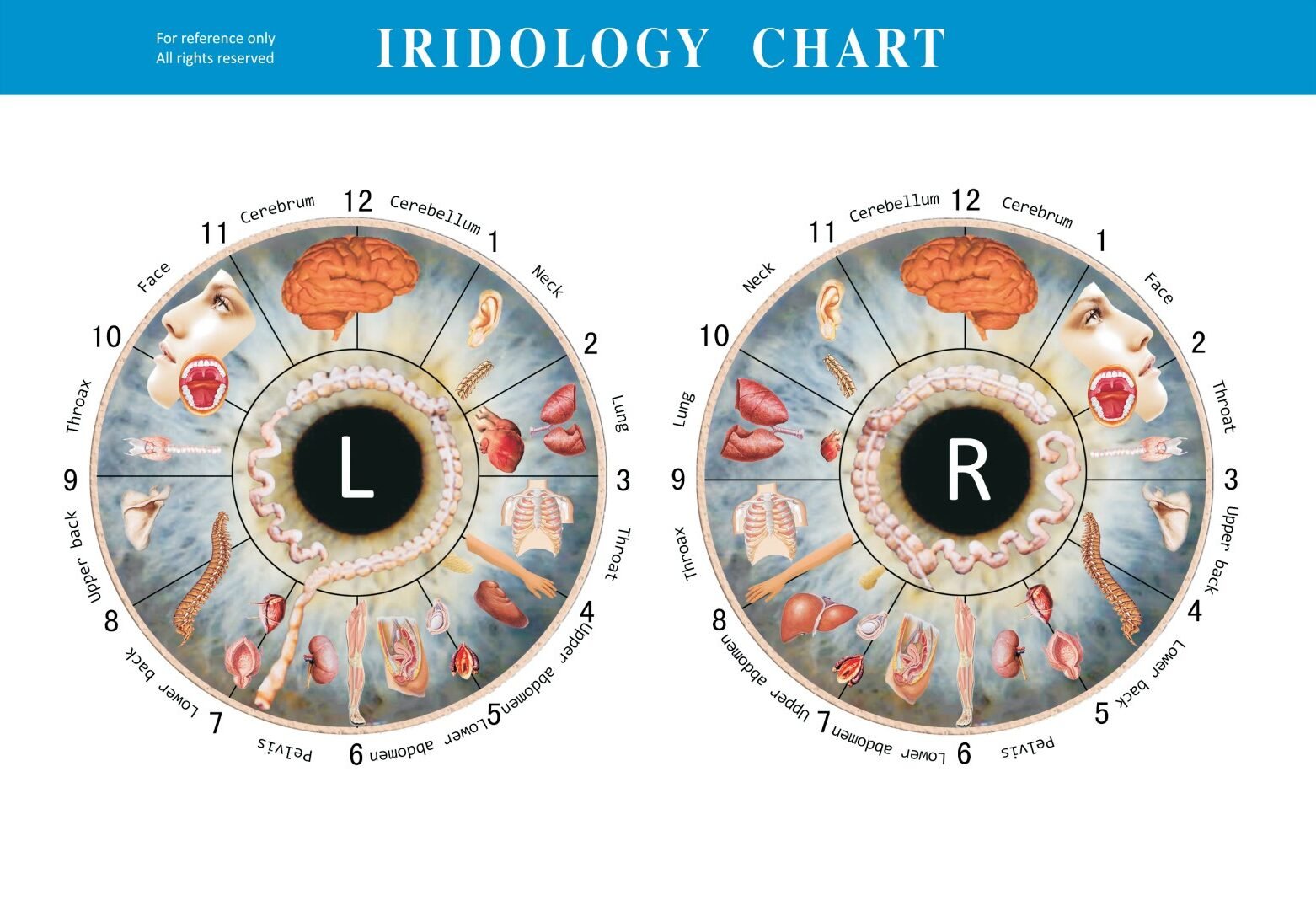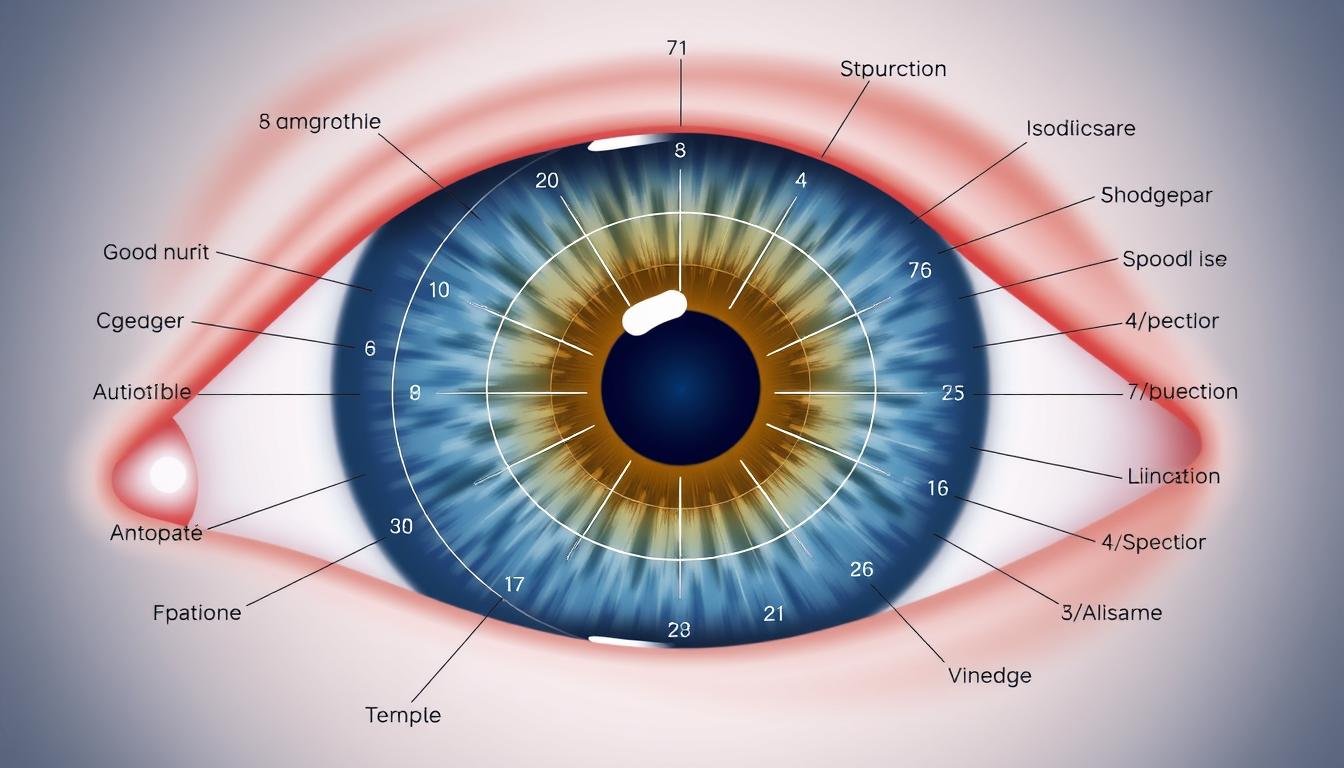The human iris contains intricate patterns unique to each individual, and according to iridology practitioners, these patterns may reveal valuable information about our health. An iridology iris chart serves as a map that divides the iris into zones, each corresponding to different organs and systems within the body. This comprehensive guide explores the fascinating world of iridology charts, their historical roots, and how they’re used in alternative health practices today.


Что такое иридология?
Iridology is the study of the iris—the colored part of your eye—to assess potential health conditions. Practitioners believe that different zones of the iris correspond to various organs and systems in the body. By examining the color, texture, and markings in specific areas of the iris, iridologists claim they can identify strengths, weaknesses, and changes in different parts of the body.
This alternative practice is based on the theory that the iris connects to every organ and tissue via the nervous system and displays changes in these tissues through nerve impulses that affect the iris fibers. The resulting patterns supposedly create a detailed health “карта” that an experienced practitioner can read.

Historical Background of Iridology
The concept of examining the iris for health insights has roots that some trace back thousands of years to ancient Egypt, China, and India. However, modern iridology as we know it today began taking shape in the 19th century.
The most widely acknowledged founder of modern iridology is Ignatz von Peczely, a Hungarian physician who developed his theories in the 1860s. As the story goes, von Peczely noticed changes in an owl’s iris after the bird suffered a broken leg. This observation sparked his interest in the connection between iris markings and physical trauma or disease.
In the early 20th century, Dr. Bernard Jensen further developed iridology in the United States, creating detailed iris charts that mapped specific areas of the iris to corresponding body parts. Jensen’s charts remain influential in modern iridology practice and form the foundation of many contemporary iridology iris charts.

Structure of an Iridology Iris Chart
A standard iridology iris chart divides the iris into approximately 80-90 zones, arranged in concentric rings around the pupil. These zones are mapped to different organs and body systems, creating a comprehensive topographical map of the body as represented in the iris.
Basic Layout of the Iridology Chart
The chart is typically organized as follows:
- The right iris corresponds to the right side of the body
- The left iris corresponds to the left side of the body
- The chart is divided into concentric rings representing different body systems
- The chart is further divided into radial zones (like slices of a pie) representing specific organs
- The pupillary zone (closest to the pupil) typically represents digestive organs
- The ciliary zone (middle area) often represents metabolic systems
- The peripheral zone (outer edge) typically represents skin, lymphatics, and extremities


Key Zones of the Iridology Iris Chart
The iridology iris chart maps specific areas of the iris to corresponding body parts and systems. Here’s a breakdown of the major zones and what they represent according to iridology practitioners:
Right Iris Zones (Right Side of Body)
- Top Region – Brain, head, and sinuses
- Верхний правый квадрант – Lungs, bronchi, and right breast
- Right Middle Area – Liver, gallbladder, and pancreas
- Нижний правый квадрант – Appendix, ascending colon, and right kidney
- Bottom Region – Reproductive organs and right leg
Left Iris Zones (Left Side of Body)
- Top Region – Cerebral circulation and mental function
- Upper Left Quadrant – Heart, spleen, and left breast
- Left Middle Area – Stomach, pancreas, and adrenal glands
- Lower Left Quadrant – Descending colon and left kidney
- Bottom Region – Reproductive organs and left leg



Concentric Ring Zones
- Digestive Ring – Encircles the pupil, representing the digestive tract
- Autonomic Nerve Wreath – Separates the pupillary and ciliary zones, indicating nervous system function
- Lymphatic System Ring – Appears in the ciliary zone, showing lymphatic circulation
- Skin Zone – The outermost ring representing skin health and external organs

Download Your Free Detailed Iridology Chart
Get instant access to our comprehensive iridology iris chart with detailed zone descriptions and body correlations. Perfect for beginners and practitioners looking to deepen their understanding of iris analysis.
Download Free Chart PDF
Interpreting Iris Markings and Colors
According to iridology theory, various markings, colors, and patterns in the iris can indicate different health conditions or predispositions. Here’s how practitioners interpret these features:
| Ирис |
Iridology Interpretation |
| White or Light Streaks |
Воспаление или гиперактивность соответствующего органа. |
| Темные пятна |
Possible toxic accumulation or damage in the corresponding area |
| Rings or Circles |
Stress or tension in related systems |
| Blue or Gray Iris |
Often associated with lymphatic constitution |
| Brown or Mixed Iris |
May indicate hematogenic (blood-related) constitution |
| Yellowish Discoloration |
Возможные проблемы с почками или мочевыводящими путями. |


Читать иридологическую карту


Sample HTML Iridology Iris Chart
Below is a simplified representation of an iridology iris chart showing the major zones and their corresponding body connections. This chart illustrates how practitioners map the iris to different body systems.



Comprehensive iridology iris chart showing 60 zones mapped to specific organs and body systems
The chart above divides the iris into 60 zones, each corresponding to specific organs and systems in the body. Practitioners use this map to identify potential health issues by examining changes in iris color, texture, and markings within these zones.
Modern Applications in Alternative Medicine
While controversial in conventional medicine, iridology continues to be practiced as a complementary assessment tool in various alternative health settings. Here are some of its modern applications:
Профилактическая оценка здоровья
Many iridologists use iris analysis as a preventive tool, claiming to identify constitutional weaknesses before symptoms manifest. This approach focuses on strengthening potentially vulnerable areas through lifestyle modifications, nutrition, and natural remedies.
Complementary Diagnosis
Some alternative practitioners use iridology alongside other diagnostic methods to form a more comprehensive health assessment. They may combine iris analysis with other techniques like pulse diagnosis, tongue examination, or conventional medical tests.
Руководство по питанию
Based on iris analysis, practitioners often recommend personalized nutritional protocols to address specific weaknesses or imbalances identified in the iris. These may include dietary changes, herbal supplements, or detoxification programs.

Научный взгляд на иридологию
The scientific community has expressed significant skepticism about iridology, and several controlled studies have failed to validate its diagnostic claims. Here’s an overview of the scientific perspective:
Arguments Supporting Iridology
- Радужная оболочка содержит тысячи нервных окончаний, связанных с мозгом
- Some practitioners report consistent patterns in their observations
- May serve as a non-invasive screening tool when used cautiously
- Could potentially identify constitutional tendencies rather than specific diseases
Научная критика
- Multiple controlled studies show iridologists cannot reliably diagnose conditions
- No physiological mechanism has been established to explain how internal organs would affect iris appearance
- The iris structure is largely determined by genetics and remains stable throughout life
- Diagnostic claims lack reproducibility in blind testing environments
A notable study published in the Journal of the American Medical Association tested the ability of iridologists to detect gallbladder disease from photographs of irises. The practitioners could not distinguish between healthy patients and those with confirmed gallbladder conditions at a rate better than chance.

Traditional vs. Modern Iridology Interpretations
Iridology has evolved over time, with some differences between traditional approaches and contemporary practice. The table below compares traditional and modern interpretations of iris signs:
| Аспект |
Traditional Interpretation |
Modern Interpretation |
| Diagnostic Approach |
Direct disease diagnosis based on iris signs |
Assessment of tendencies and constitutional weaknesses |
| Iris Changes |
Believed to change rapidly with health conditions |
Recognized as relatively stable with gradual changes |
| Technology Use |
Ручной осмотр с помощью увеличительных инструментов |
Digital imaging and computer analysis |
| Integration |
Standalone diagnostic system |
Complementary to other assessment methods |
| Treatment Focus |
Treating specific diseases identified |
Preventive approach and constitutional support |

Практические применения диаграмм иридологии
For those interested in exploring iridology, here are some practical ways the iris chart is applied in alternative health settings:
Self-Assessment Basics
While professional analysis is recommended, some basic self-observation can be done with a good quality mirror and adequate lighting. Look for obvious markings, color variations, and structural features in your iris, then reference them against a standard иридологическая карта.
Working with Practitioners
Professional iridologists typically use specialized equipment to photograph and analyze the iris in detail. They may create personalized iris maps that track changes over time and develop customized health recommendations based on their findings.
Integrating with Other Health Approaches
Many holistic health practitioners use iridology as one component of a broader assessment that might include nutritional analysis, physical examination, and health history review. This integrated approach provides a more comprehensive picture than iris analysis alone.

Deepen Your Understanding of Iridology
Ready to explore iridology in greater depth? Our comprehensive “Beginner’s Guide to Iridology” ebook includes detailed zone interpretations, case studies, and practical applications for personal health assessment.
Download Complete Guide
Conclusion: The Place of Iridology in Health Assessment
The iridology iris chart represents a fascinating intersection of traditional observation and alternative health theory. While scientific evidence doesn’t currently support many of the diagnostic claims made by iridology practitioners, the practice continues to be used as a complementary assessment tool in holistic health settings.
For those interested in exploring iridology, it’s important to approach it with an informed perspective—understanding both its limitations from a scientific standpoint and its potential value as one component of a broader health assessment. Whether viewed as a legitimate diagnostic tool or simply an interesting alternative perspective, the iridology iris chart offers a unique lens through which to consider the complex connections between different aspects of human health.



































